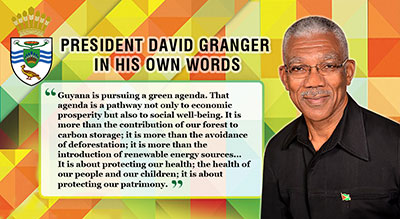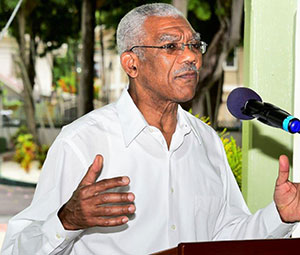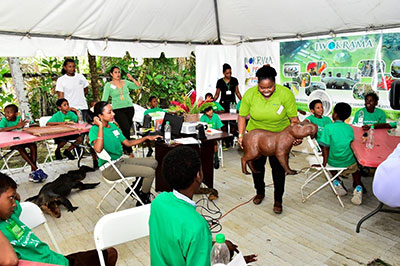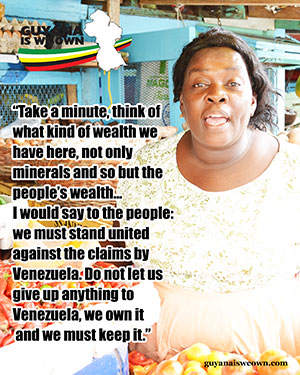IN a ‘green’ state, Government is expected through policies, programmes and laws to create an enabling environment where Guyanese can realise their true potential in various sectors. In their economic pursuits, the ‘green’ state teaches reliance on techniques that reduce or

eradicate harmful effects on the environment and the people. This ‘green’ state will offer green and well-paying jobs, economic opportunities, individual equality, justice, and political empowerment.
In his New Year message to the people of Guyana, President David Granger said that the year 2017 will see Government moving purposefully along the path towards the establishment of a ‘green’ state. The plan, he said, would involve the use of renewable energy resources and less dependence on fossil fuels, the promotion of the protection of our natural environment by the conservation of our fauna and flora, economic diversification and other initiatives.
“The establishment of a ‘green’ state will reduce the impact of the economic and environmental shocks which have retarded our development. The ‘green’ state will reduce our country’s carbon footprint. The ‘green state will diversify our economic base and promote increased value-added production…We belong to a beautiful, blissful, bountiful country that possesses abundant natural resources. We must care these resources. We must conserve their use for the benefit of present and future generations,” the President said. 
In November, 2016, as a result of President Granger’s attendance at the Joint High Level Segment (HLS) of the 22nd Conference of Parties (COP22) in Marrakesh, Kingdom of Morocco, Guyana secured an engagement with the United Nations Environment Programme (UNEP) to develop a Framework for the Green State Development Strategy (GSDS).
The ‘Framework of the Guyana Green State Development Strategy and Financing Mechanisms’ was finalised and made public in April this year and is intended to lay out the elements to be examined and consulted on during the course of the development of the strategy, a process which is expected to last until December 2017.
The strategy will place emphasis on the balance between the three dimensions of sustainable

Government moving purposefully along the path towards the
establishment of a ‘green’ state
development: economic, social and environmental, to ensure comprehensive implementation and will see several transformative developments. These include: the enhancement of social cohesion and inclusion, improving quality of living for all Guyanese, promoting sustainable lifestyles and protection of the environment, the sustainable use of biodiversity and increased resource efficiency, aiming for a transition to 100% renewable energy by 2025, redirecting and mobilising investments, ensuring transparency and sharing services and decision-making to the population and engaging civil society and creating a space for citizen participation.
President Granger has said that an important feature of Guyana’s ‘green’ pathway to development is ensuring that there is a wide cross-section of stakeholder inputs, to ensure a people-centred approach to the country’s transformation.
It is with this in mind that the President, on May 3, reactivated the Green Multi-Stakeholder Steering Committee (GMSSC), which will seek to allow for stakeholder inputs in the governing mechanism of both the Low Carbon Development Strategy (LCDS) and the ‘green’ state development strategy.
The committee includes stakeholders from Government agencies and ministries, including the Guyana Lands and Surveys Commission (GL&SC), Guyana Forestry Commission (GFC), Ministry of Agriculture, Ministry of Business, Amerindian People’s Association (APA), the

flora and fauna during Iwokrama’s
21st Anniversary Celebrations
Amerindian Action Movement, the Opposition, the Department of Environment, Office of Climate Change, Project Management Office and several other Government and non-governmental organisations. The committee was first established in 2009 through a Guyana-Norway Agreement and was tasked with establishing a model of environmental governance, but had not met since 2015.
The President highlighted the value of the LCDS, particularly with regard to identifying how countries can be rewarded for providing climate-mitigating services. However, the President said that the transition toward becoming a ‘green’ state goes beyond the LCDS.
This involves a holistic transformation, which aims at human development, poverty eradication, reducing inequality, increasing employment, promoting sustainable livelihoods and building economic and environmental resilience. As a result, the President said that this approach requires sustained consultation and inclusivity, which is where the committee comes in.
Head of the Department of the Environment, Ms. Ndibi Schwiers, said that the committee serves as an important platform for national  engagement and a mechanism for the monitoring and evaluation of the Green State Development Projects.
engagement and a mechanism for the monitoring and evaluation of the Green State Development Projects.
While stakeholder participation is important, the work of the agencies dealing with the environment must also correlate with each other in order to have a unified approach on the path toward becoming a green state.
Following the meeting of the Green Multi-Stakeholder Steering Committee, the President met with board members of the environmental agencies, which fall under the aegis of the Department of the Environment, and reminded them that a collaborative approach is needed to protect and preserve the nation’s patrimony.
The President said that frequent communication among these agencies is important to ensure that their work is complementary and cooperative. “Unfortunately, the way some of the agencies and boards grew up, they did not need to develop the habit of collaborating with other agencies and boards… that is an accident of history; but now we deliberately have to work toward getting out of our silos and speaking with each other and I regard this conference, this morning, as an attempt to reach beyond our specific mandates and develop a more multi-agency approach; a multi-year approach, because what you are doing is not just for this year or next year, it is something that will have an imprint on the rest of Guyanese history,” he said.
Moreover, the President said that the Department of the Environment — which was established in October 2016 — will help to ensure that a collaborative approach is maintained, but stated that it is also important that the flagship agencies are led by Guyanese, and that the country must develop the expertise to manage the environment in the best interest of its citizens.
At that meeting, board members expressed their agreement with the President’s vision, and stated their intention to heed the Head of State’s call to work together.
Chairperson of the Protected Areas Commission (PAC), Dr Raquel Thomas, said that the management of protected areas is an important component of any ‘green’ state. She noted that Protected Areas are an important component of any green state, and that Guyana’s recent pledge of allocating an additional two million hectares of land for conservation is a significant move for the country. She added, however, that the President’s call to walk on two feet with regard to the sustainable use of our resources is also important. “We can’t just talk the talk but we have to walk the walk. I think for this green state economy to work all have to be involved. We need a very stringent public awareness. People might hear of terms, but often they don’t understand exactly what they mean and that’s why it is very important to have people involved. The whole concept about conservation and sustainable use is about people. Areas will protect themselves if people were not involved, so it is really about working around people, working with people and have people involved in the process of management,” she said.
Chairperson of the Environmental Protection Agency (EPA), Dr Patrick Williams, pledged to ensure that the decisions made by the agency will align with the President’s vision. He said that the EPA is aware of the issues surrounding climate change and the importance of protecting the environment and pledged that the board would work to ensure that the agency’s work is in line with the President’s vision. “We believe that the Green State development strategy is the overarching principle that we are going to use to make some of our decisions in terms of environmental conservation, and also what kinds of development we are going to support and how we are going to support them.
And so the idea then is to ensure that the decisions that we make are in consonance with what the President has outlined. We know that there may be some areas of conflict that we have to address, but we will try to ensure that in doing so that we think very carefully about the broader picture and that we need to be rational about our decision-making,” he said.
From the establishment of the Department of the Environment, to the development of the Green State Development Strategy, the strengthening of bilateral relations to ensure climate-financing partnerships, Government continues to put several steps in place to ensure the advancement of Guyana’s Green Agenda.
These and other steps are just the beginning of a holistic plan to ensure that Guyana’s future is secured as a state, which is able to protect its environment, combat the adverse effects of climate change, while still ensuring the sustainable development of the country.
Guyana’s Green Agenda is a vision of President David Granger aimed at ensuring that Guyana is a country built on environmental sustainability, while balancing its economic development in a manner that ensures the protection of Guyana’s national patrimony while promoting economic advancement. Government will continue to seek opportunities that will see Guyana becoming a Green State where all Guyanese can reap the benefits.



.jpg)








